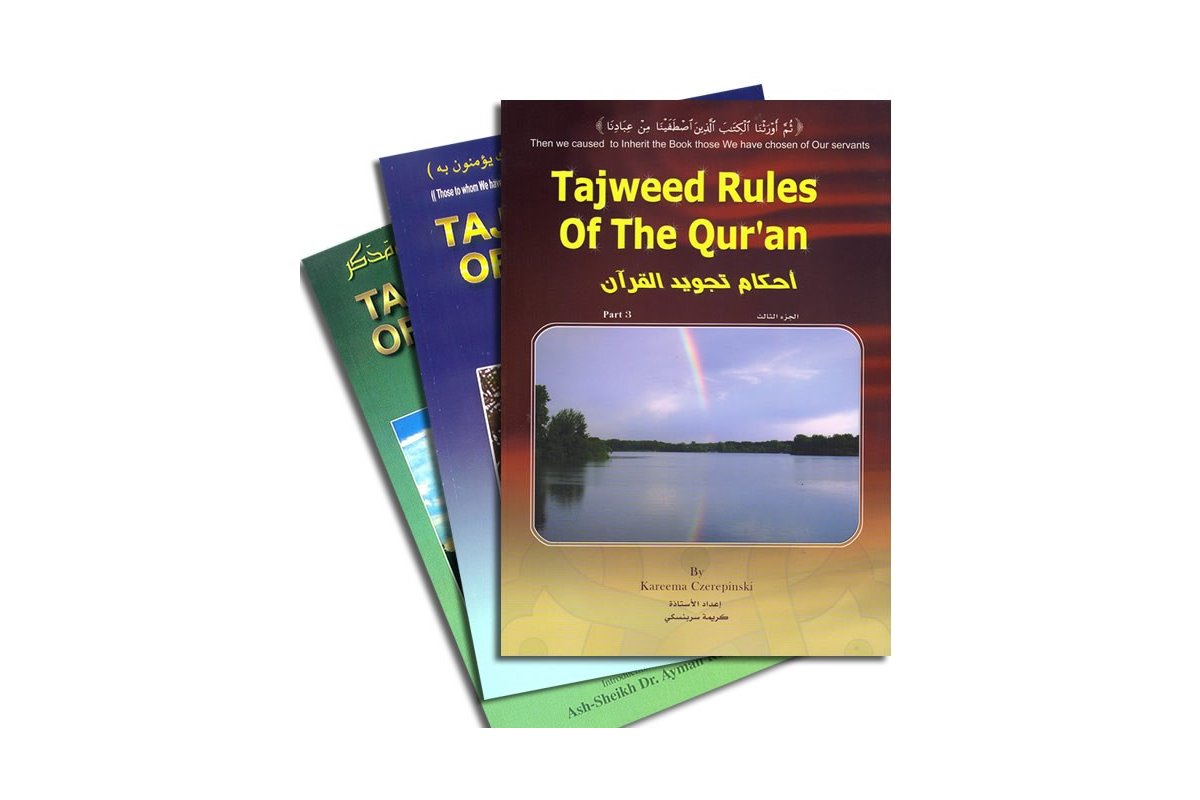Table of Contents
- 1 What are the rules of Tajweed?
- 2 What is Tajweed in Quran?
- 3 How to Read Quran Correctly:
- 4 Importance of tajweed
- 5 Tajweed Rules for Beginners
- 5.1 Correct Pronunciation:
- 5.2 Lengthening Sounds (Madd):
- 5.3 Pausing and Stopping:
- 5.4 Qalqalah (Echo or Bouncing Sound):
- 5.5 Rules of Ghunnah:
- 5.6 Rules of Raa:
- 5.7 Rules of Laam:
- 5.8 The rule of the moon and sun letters
- 5.9 Rule of Hamzatul Wasl and Hamzatul Qat
- 5.10 Arabic Heavy Letters:
- 5.11 Rules of Tanween and Noon Sakinah:
- 5.12 Meem Sakinah rules
- 6 Conclusion
- 7 FAQs
What are the rules of Tajweed?
We are truly blessed to have the guidance of the divine book of Almighty Allah. Muslims around the world share a deep connection with the Holy Quran. However, many non-Arab Muslims struggle to read it flawlessly in Arabic, striving to avoid any mistakes.
Tajweed is the set of rules that govern the proper recitation of the Quran. These rules encompass correct pronunciation, intonation, and other crucial aspects necessary for reciting the Holy Quran accurately. It is the duty of every Muslim to understand and implement Tajweed rules, as reciting the Quran without following Tajweed means reciting it incorrectly.
In this blog post, we will explore the rules of Tajweed, understand its meaning and significance, delve into its basic principles, and discuss how you can learn and apply Tajweed in your journey of Quranic recitation.
Meaning of Tajweed
What is Tajweed in Quran?
The term “tajweed” originates from the Arabic word “Jawwada,” which means to enhance or beautify. It encompasses a set of rules established by classical Arabic scholars to facilitate the recitation of the Quran for people worldwide, regardless of whether they are Arab or non-Arab.
The rules of tajweed for beginners serve as a guide for correctly reciting the Holy Quran, ensuring that it is recited in a manner similar to how it was revealed to Prophet Muhammad (peace be upon him).
How to Read Quran Correctly:
Tajweed plays a significant role in the recitation of the Quran. It serves as a guide for reading the Holy Book exactly as it was revealed to Prophet Muhammad (peace be upon him), helping us avoid recitation errors, maintain consistency, and prevent misinterpretations. Moreover, Tajweed enhances our understanding of the Quranic text.
Importance of tajweed
Tajweed is the set of rules that govern the proper pronunciation and recitation of the Quran, the holy book of Islam. The importance of Tajweed in Islam cannot be overstated. Here are a few reasons why Tajweed is so significant:
Preservation of the Quran:
Tajweed helps to ensure the accurate and correct recitation of the Quran. By following the rules of Tajweed, Muslims can be sure that they are reciting the Quran as it was revealed to Prophet Muhammad (peace be upon him) and passed down through the generations. Tajweed helps to preserve the purity and authenticity of the Quran.
Beautification of recitation:
Tajweed helps to beautify the recitation of the Quran. By following the rules of Tajweed, Muslims can add melody, rhythm, and harmony to their recitation, making it more pleasant to listen to and easier to memorize. Tajweed can also enhance the emotional impact of the Quran and help listeners to connect more deeply with its message.
Understanding of the Quran:
Tajweed can also aid in the understanding of the Quran. By following the rules of Tajweed, Muslims can more easily distinguish between similar-sounding letters and words, leading to a better comprehension of the meaning of the Quranic verses.
Spiritual benefits:
Tajweed can have spiritual benefits as well. By reciting the Quran with proper Tajweed, Muslims can feel a greater sense of connection to Allah and the Prophet Muhammad (peace be upon him).Additionally, Tajweed can help to improve one’s focus and concentration during recitation, leading to a more meaningful and fulfilling spiritual experience.
Tajweed is essential for the proper recitation and understanding of the Quran. It helps to preserve the authenticity and purity of the Quran, beautify its recitation, aid in its comprehension, and provide spiritual benefits to those who recite it with proper Tajweed. Tajweed is an integral part of Islamic education and should be studied and practiced by all Muslims who recite the Quran.
Tajweed Rules for Beginners
Correct Pronunciation:
One of the first lessons and important Tajweed guidelines that your teacher will help you master is accurately pronouncing Arabic letters. Every Arabic letter has its own identity and is pronounced distinctly.
For example, the letter “ص” (Saad) is pronounced with a resounding “S” sound. While the letter س Seen gives a distinct sound, as it is pronounced more lightly than the letter Saad.
Pronouncing each letter correctly is critical for correctly reciting the Quran, as a minor difference in pronunciation can completely affect the meaning of the word.
Lengthening Sounds (Madd):
Madd means to elongate or stretch the word. It appears in many forms in the Holy Quran. Each type of Madd possesses a different elongation rule and application. These rules focus on how the lengthening should occur, depending on various conditions. For example, the long Madd is lengthened for 4 seconds, while the short Madd is lengthened for 2-3 seconds.
Types of Madd:
• Madd Tabee’ee
• Madd Al-Badal
• Madd Ewadh
• Madd Aaridh Li-Ssukoon
• Madd Al-Leen
• Madd Waajib Muttasil
• Madd Jaa’ez Munfasil
• Madd Laazim
Pausing and Stopping:
Understanding pausing and stopping sounds is very crucial for the accurate recitation and understanding of any verse or part of the verse. These rules are called rules of waqf. Various symbols indicate whether the reciter should keep reading, pause, or stop before continuing to the next verse.
These symbols are crucial because a slight mistake in following the rules of waqf can entirely change the meaning of the text.
For example, ج symbols highlight the permissible stop, لا showing that there is no need of stopping while appears at the end of the verse.
Qalqalah (Echo or Bouncing Sound):
Qalqalah is a rule of producing bouncing or echoing sounds when certain letters are pronounced. There are five letters that have Qalqalah: ق (Qaf), ط (Taa), ب (Ba), ج (Jeem), and د (Dal). When any of these letters appear with sukoon (a silent or unstressed vowel) in the middle or end of the word, a slight bouncing sound is added to their pronunciation.
Example:
أطعمهم
Here the letter ط appears, therefore the rule of Qalqalah is followed.
Rules of Ghunnah:
There are certain different rules and applications of the Ghunnah. Gunnah means to produce a nasal sound and lengthen a letter for 1 second. Ghunnah occurs when certain letters are followed by ن (noon) or م (meem)
Rules of Raa:
The letter Raa (ر) has different rules associated with it and is pronounced in different ways. The pronunciation depends on many factors, such as the presence of Fatha or Dhamma, or Kasra. For example, when Fatha comes to the letter Raa, it is pronounced heavily and called “heavy” Raa (Raa’ Jameel). While Kasra’s inclusion in the letter Raa denotes the presence of Raa’ Khafi, the “light” Raa.
Rules of Laam:
The letter Laam has certain rules that affect its pronunciation when it is followed by specific letters. For example, Laam can assimilate with a subsequent letter, merge smoothly, or be pronounced distinctly, depending on the rules of Laam which are called Sun and Moon letters in Arabic.
The rule of the moon and sun letters
The 28 Arabic letters are divided into 14 sun letters (الحروف الشمسية) and 14 moon letters (الحروف القمرية) based on the pronunciation of definite article. Whenever a word starting with a sun letter meets the definite article, the laam in the definite article becomes silent while hamzatul wasl is pronounced.
In contrast, the definite article is pronounced with the word that starts with the moon letter and has no influence on the pronunciation of the hamzatul wasl or laam.
Rule of Hamzatul Wasl and Hamzatul Qat
The rule of hamzatul wasl and Hamzatul Qat is one of the essential rules of the tajweed. The rule is simple, but many learners find it complex to differentiate between the two due to the lack of proper guidance.
Hamzatul Qat is a non-connecting Hamza represented by a small letter hamza (ء) placed above the first letter of the word. It is also called a cutting hamza. When a word initiates with a letter with sukoon or hamza, hamzatul Qat is pronounced as a glottal stop. while hamzatul Wasl is a connecting hamza because it connects the word to the preceding word in recitation and speech.
Arabic Heavy Letters:
In the Arabic language, there are 7 letters that are known as the “heavy letters” or “emphatic letters”. These letters are pronounced with a heavy emphasis and have a distinct sound from their non-emphatic counterparts. The 7 heavy letters in Arabic are:
- ط (ṭāʾ)
- ص (ṣād)
- ق (qāf)
- خ (khāʾ)
- ظ (ẓāʾ)
- ض (ḍād)
- غ ( ghain)

These letters are important in Arabic because they change the meaning of words and can also affect grammar. It is important for learners of Arabic to master the pronunciation of these letters in order to accurately communicate in the language.
Rules of Tanween and Noon Sakinah:
Tanween refers to the double short vowels (such as -an, -in, -un) that are added to the end of nouns or verbs. Noon Sakinah refers to the Noon sound with a sukoon at the end of a word. These require specific pronunciation techniques and rules when transitioning to the next word.
Noon Sakinah and Tanween have four rules
1- Ikhfa
2- Idgham
3- Iqlab
4- Izhar.
Meem Sakinah rules
In the Arabic language, “Meem Sakinah” refers to the letter meem (م) that appears at the end of a word and is not followed by a vowel. There are specific rules that apply to Meem Sakinah and they are as follows:
Idgham.
Izhar.
Ikhfa.
These rules are important for proper pronunciation and understanding of Arabic. Learners of Arabic should practice these rules to improve their fluency and accuracy in the language.
Note: these are a general overview of different tajweed rules, and there are more detailed rules and exceptions within each category. Tajweed is a vast science that requires thorough focus, attention, and most importantly, the guidance of an experienced instructor. It is best to learn under the guidance of a qualified teacher that has expertise in teaching the Quran with tajweed.
Conclusion
In conclusion, learning the Tajweed rule is essential for every Muslim around the world, as it ensures accurate pronunciation and clarity and helps us connect deeply with the message of the Quran.
If you are interested in learning Tajweed and enhancing your Quranic recitation, consider enrolling in the Online Quran Recitation with Tajweed course.
Ehsan provides structured learning, interactive sessions, and expert guidance for adults and kids alike. Get enrolled in Tajweed classes for adults and kids to start your beautiful journey toward Quran and Allah.
Learning tajweed can be challenging, especially if you live in a non-Muslim country. But that doesn’t give you an excuse to recite Quran without proper tajweed.
FAQs
How long does it take to learn Quran with Tajweed?
The duration to learn Tajweed varies depending on factors such as the individual’s dedication, prior knowledge, and practice frequency. It can take several months to a few years to gain proficiency. Consistent practice and guidance from qualified teachers significantly speed up the learning process.
Can I learn Tajweed online?
Yes, there are reputable online platforms, like Ehsan Academy, that offer structured Tajweed courses for learners of all levels. These courses provide interactive sessions, personalized instruction, and the flexibility to learn at your own pace from the comfort of your home.
Is Tajweed only for advanced learners?
A: Tajweed is beneficial for learners at all levels, including beginners. Starting with the basics of Tajweed lays a firm foundation for accurate recitation and understanding of the Quranic text. Ehsan Academy offers great tajweed for beginners course.
How to learn tajweed?
Learning Tajweed requires dedicated effort and practice, but it can be accomplished through the following steps:
Learn the Arabic alphabet:
Tajweed involves precise pronunciation of Arabic letters and sounds, so it’s essential to first learn the Arabic alphabet and its pronunciation. This will help you to better understand and apply the rules of Tajweed.
Study the rules of Tajweed:
Tajweed has a set of rules and guidelines that govern the pronunciation of each letter and the way words are recited. There are numerous resources available, such as books, videos, and online courses that can help you learn and understand these rules.
Practice regularly:
Regular practice is key to learning and mastering Tajweed. Start by reciting short verses or chapters of the Quran and focus on applying the Tajweed rules you have learned. Listen to recitations by experienced reciters and try to mimic their pronunciation, melody, and rhythm.
Seek guidance from an experienced teacher:
It is highly recommended to seek guidance and instruction from an experienced Tajweed teacher. A knowledgeable teacher can provide personalized feedback, identify areas that need improvement, and guide you through the learning process.
What is the Tajweed of Quran?
Tajweed refers to the set of rules that govern the proper pronunciation and recitation of the Quran. Tajweed is therefore about improving the way the Quran is recited, and it is considered an essential part of Islamic education.
The Tajweed of Quran includes rules that cover the pronunciation of each of the Arabic letters, the way words are pronounced, and the melody and rhythm of recitation. Tajweed ensures that the Quran is recited correctly and with the correct meaning and emphasis. Tajweed is also important for the spiritual and emotional impact of recitation, as it can add beauty and depth to the recitation of the Quran.
Tajweed rules cover various aspects of pronunciation, such as elongation (madd), emphasis (tashdeed), nasalization (ghunnah), and silent letters (sukoon). There are also rules related to the melody and rhythm of recitation, such as the length of pauses and the way certain letters are stretched or emphasized.
Learning and applying Tajweed rules requires practice, dedication, and guidance from an experienced teacher. Tajweed is an integral part of Islamic education, and it is considered a highly respected and noble skill. Muslims around the world strive to learn and apply Tajweed rules in their recitation of the Quran, as it is considered a means of improving their connection with Allah and deepening their understanding of the Quranic message.







